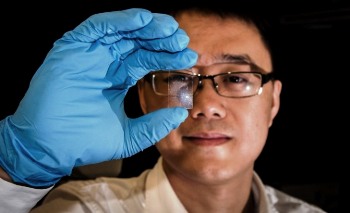May 31 2013
Cameras fitted with a new revolutionary sensor will soon be able to take clear and sharp photos in dim conditions, thanks to a new image sensor invented at Nanyang Technological University (NTU).
 New sensor a thousand times more sensitive than current camera sensors
New sensor a thousand times more sensitive than current camera sensors
The new sensor made from graphene, is believed to be the first to be able to detect broad spectrum light, from the visible to mid-infrared, with high photoresponse or sensitivity. This means it is suitable for use in all types of cameras, including infrared cameras, traffic speed cameras, satellite imaging and more.
Not only is the graphene sensor 1,000 times more sensitive to light than current imaging sensors found in today’s cameras, it also uses 10 times less energy as it operates at lower voltages. When mass produced, graphene sensors are estimated to cost at least five times cheaper.
Graphene is a million times smaller than the thickest human hair (only one-atom thick) and is made of pure carbon atoms arranged in a honeycomb structure. It is known to have a high electrical conductivity among other properties such as durability and flexibility.
The inventor of the graphene sensor, Assistant Professor Wang Qijie, from NTU’s School of Electrical & Electronic Engineering, said it is believed to be the first time that a broad-spectrum, high photosensitive sensor has been developed using pure graphene.
His breakthrough, made by fabricating a graphene sheet into novel nano structures, was published this month in Nature Communications, a highly-rated research journal.
“We have shown that it is now possible to create cheap, sensitive and flexible photo sensors from graphene alone. We expect our innovation will have great impact not only on the consumer imaging industry, but also in satellite imaging and communication industries, as well as the mid-infrared applications,” said Asst Prof Wang, who also holds a joint appointment in NTU’s School of Physical and Mathematical Sciences.
“While designing this sensor, we have kept current manufacturing practices in mind. This means the industry can in principle continue producing camera sensors using the CMOS (complementary metal-oxide-semiconductor) process, which is the prevailing technology used by the majority of factories in the electronics industry. Therefore manufacturers can easily replace the current base material of photo sensors with our new nano-structured graphene material.”
If adopted by industry, Asst Prof Wang expects that cost of manufacturing imaging sensors to fall - eventually leading to cheaper cameras with longer battery life.
How the Graphene nanostructure works
Asst Prof Wang came up with an innovative idea to create nanostructures on graphene which will “trap” light-generated electron particles for a much longer time, resulting in a much stronger electric signal. Such electric signals can then be processed into an image, such as a photograph captured by a digital camera.
The “trapped electrons” is the key to achieving high photoresponse in graphene, which makes it far more effective than the normal CMOS or CCD (charge-coupled device) image sensors, said Asst Prof Wang. Essentially, the stronger the electric signals generated, the clearer and sharper the photos.
“The performance of our graphene sensor can be further improved, such as the response speed, through nanostructure engineering of graphene, and preliminary results already verified the feasibility of our concept,” Asst Prof Wang added.
This research, costing about $200,000, is funded by the Nanyang Assistant Professorship start-up grant and supported partially by the Ministry of Education Tier 2 and 3 research grants.
Development of this sensor took Asst Prof Wang a total of 2 years to complete. His team consisted of two research fellows, Dr Zhang Yongzhe and Dr Li Xiaohui, and four doctoral students Liu Tao, Meng Bo, Liang Guozhen and Hu Xiaonan, from EEE, NTU. Two undergraduate students were also involved in this ground-breaking work.
Asst Prof Wang has filed a patent through NTU’s Nanyang Innovation and Enterprise Office for his invention.
The next step is to work with industry collaborators to develop the graphene sensor into a commercial product.